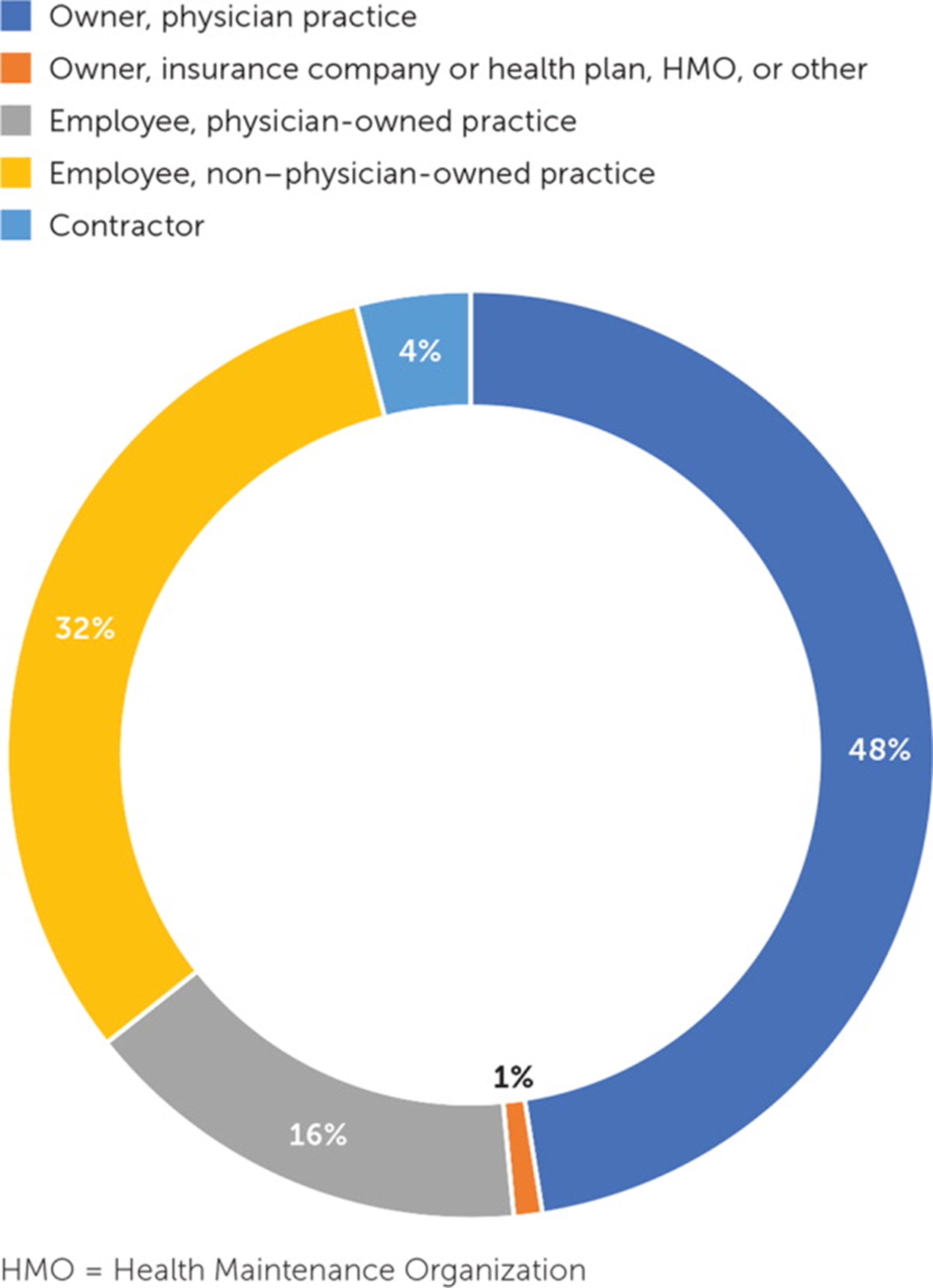Physician Employment Eclipses Practice Ownership: The Ongoing Trend and Its Effect on Family Medicine
One Pagers | Oct. 01, 2021
Julie Hyppolite, MD, MPH; Brian Antono, MD, MPH; Stephen Petterson, PhD; And Yalda Jabbarpour, MD
Am Fam Physician. 2021 Oct ;104(4):351-352.
In 2016, for the first time, less than one-half of practicing physicians had an ownership stake in their own practices.1 The most recent American Medical Association Physician Practice Benchmark Survey reveals that this trend continues.2 More physicians are identifying as employees instead of owners, with family physicians being the second most likely specialty to be employed. This trend has significant implications for reimbursement and practice patterns, and potential impacts on physician burnout if scope is limited by employers.2,3
The Robert Graham Center, in conjunction with researchers at the American Board of Family Medicine and IBM Watson Health, examined employment trends in the report “Primary Care in the United States, A Chartbook of Facts and Statistics.” 4 Employment status of primary care physicians was analyzed using 2016 National Ambulatory Medical Care Survey data (Figure 1). Slightly less than one-half (49%) of primary care physicians owned their own practices. Most working physicians were employees of a non–physician-owned practice.

FIGURE 1.
Primary care physicians by employment status.
Source: National Ambulatory Medical Care Survey, 2016.
The increasing percentage of employed physicians may be due to a variety of factors, including greater financial stability.5 Younger physicians are also reported to be less attracted to the entrepreneurial aspect of private practice ownership.6 Although these trends may reflect financial and lifestyle decisions, the implications of a largely employed primary care workforce are not necessarily positive. For example, employers in multispecialty practices could be defining or limiting the scope of practice of their physicians, which has implications for training, physician satisfaction, and health care costs.3,7
The impact of employment status on health care quality is still unclear. Some studies suggest that it has no relationship to health care quality.2 Other studies show that primary care ownership is associated with less use of quality improvement process measures in comparison with federally qualified health centers and hospital-owned practices.8,9 In addition, hospital-owned practices demonstrated greater use of evidence-based chronic care management processes, which may improve care coordination.9
Although there are benefits to choosing employment instead of ownership, the disadvantages for primary care physicians and their patients may be significant and are worth further exploration.
Author disclosure: No relevant financial affiliations.
REFERENCES
1. Kane CK. Policy research perspectives. Updated data on physician practice arrangements: for the first time, fewer physicians are owners than employees. American Medical Association. May 2019. Accessed April 20, 2021. https://www.ama-assn.org/system/files/2019-07/prp-fewer-owners-benchmark-survey-2018.pdf
2. Schwartz K, Lopez, E, Rae M, et al. What we know about provider consolidation. Kaiser Family Foundation. September 2, 2020. Accessed April 20, 2021. https://www.kff.org/health-costs/issue-brief/what-we-know-about-provider-consolidation/
3. Weidner AKH, Phillips RL Jr, Fang B, et al. Burnout and scope of practice in new family physicians [published correction appears in Ann Fam Med. 2018;16(4):289]. Ann Fam Med. 2018;16(3):200–205.
4. Willis J, Antono B, Bazemore A, et al. Primary care in the United States: a chartbook of facts and statistics. October 2020. Accessed April 20, 2021. https://www.graham-center.org/content/dam/rgc/documents/publications-reports/reports/PrimaryCareChartbook2021.pdf
5. Singleton T, Miller P. The physician employment trend: what you need to know. Fam Pract Manag. 2015;22(4):11–15.
6. Darves B. Understanding the physician employment ‘movement.’ NEJM Career Center. July 23, 2014. Accessed April 20, 2021. https://www.nejmcareercenter.org/article/understanding-the-physician-employment-movement-/
7. Bazemore A, Petterson S, Peterson LE, et al. More comprehensive care among family physicians is associated with lower costs and fewer hospitalizations. Ann Fam Med. 2015;13(3):206–213.
8. Lindner S, Solberg LI, Miller WL, et al. Does ownership make a difference in primary care practice? J Am Board Fam Med. 2019;32(3):398–407.
9. Bishop TF, Shortell SM, Ramsay PP, et al. Trends in hospital ownership of physician practices and the effect on processes to improve quality. Am J Manag Care. 2016;22(3):172–176.
The information and opinions contained in research from the Graham Center do not necessarily reflect the views or the policy of the AAFP.
This series is coordinated by Kenny Lin, MD, MPH, deputy editor.